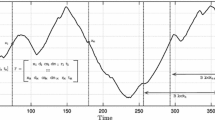Abstract
Multivariate time series classification is of significance in machine learning area. In this paper, we present a novel time series classification algorithm, which adopts triangle distance function as similarity measure, extracts some meaningful patterns from original data and uses traditional machine learning algorithm to create classifier based on the extracted patterns. During the stage of pattern extraction, Gini function is used to determine the starting position in the original data and the length of each pattern. In order to improve computing efficiency, we also apply sampling method to reduce the searching space of patterns. The common datasets are used to check our algorithm and compare with the naive algorithms. Experimental results are shown to reveal that much improvement can be gained in terms of interpretability, simplicity and accuracy.
Similar content being viewed by others
References
Aach J, Church GM (2001) Aligning gene expression time series with time warping algorithms. Bioninformatics 17:495–508
Abarbanel HDI, Carroll TA, Pecora LM, Sidorowich JJ, Tsimring LS (1994) Predicting physical variables in time-delay embedding. Phys Rev E 49:1840–1853
Alcock RJ, Manolopoulos Y (1999) Time-series similarity queries employing a feature-based approach. In: Proceeding of the 7th Hellenic conference on informatics, Ioannina, Greece
Alonso Gonzalez CJ, Rodriguez Diez JJ (2000) Time series classification by boosting interval based literals. Intel Artif Rev Iberoam Intel Artif 11:2–11
Ashkenazy Y, Ivanov PC, Havlin S, Peng CK, Goldberger AL, Stanley HE (2001) Magnitude and signal correlations in heartbeat fluctuations. Phys Rev Lett 86:1900–1903
Berndt D, Clifford J (1994) Using dynamic time warping to find patterns in time series. In: AAAI workshop on knowledge discovery in databases, pp 229–248
Boshoff HFV, Grotepass M (1991) The fractal dimension of fricative speech sounds. In: Proceedings of the South African symposium on communication and signal processing, pp 12–61
Buchler JR, Kollath Z, Serre T, Mattei J (1996) Nonlinear analysis of the lightcurve of the variable star R Scuti. Astrophys J:462–489
Casdagli M, Mackay RS (1989) Nonlinear prediction of chaotic time series. Physica D 35:335–356
Chu S, Keogh E, Hart D, Pazzani M (2002) Iterative deepening dynamic time warping for time series. In: Proceeding of SIAM international conference on data mining, pp 195–212
Ding Q, Zhuang Z, Zhu L, Zhang Q (1999) Application of the chaos, fractal and wavelet theories to the feature extraction of passive acoustic signal. Acta Acust 24:197–203
Farmer JD, Sidorowich JJ (1988) Exploiting chaos to predict the future and reduce noise. In: Lee YC (ed) Evolution, learning, and cognition. World Scientific, Singapore, pp 277–330
Geurts P (2001) Pattern extraction for time series classification. In: Principles of data mining and knowledge discovery. LNAI, vol 2168. Springer, Berlin, pp 115–127
Kadous MW (1999) Learning comprehensible descriptions of multivariate time series. In: Proceedings of the 16th international conference on machine learning, pp 454–463
Kadtke J (1995) Classification of highly noisy signals using global dynamical models. Phys Lett A 203:196–202
Keogh E, Kasetty S (2003) On the need for time series data mining benchmarks: a survey and empirical demonstration. Data Mining Knowl Discov 7(4):349–371
Keogh E, Ratanamahatana CA (2005) Exact indexing of dynamic time warping. Knowl Inf Syst 7(3):358–386
Kudo M, Toyama J, Shimbo M (1999) Multidimensional curve classification using passing-through regions. Pattern Recognit Lett 20(11–13):1103–1111
Kyusung K, Parlos AG (2002) Induction motor fault diagnosis based on neuropredictors and wavelet signal processing. IEEE/ASME Trans Mechatron 7(2):201–219
Manganaris S (1997) Supervised classification with temporal data. PhD thesis, Vanderbilt University
Petry A, Augusto D, Barone C (2002) Speaker identification using nonlinear dynamical features. Chaos Solitons Fractals 13:221–231
Povinelli RJ, Johnson MT, Lindgren AC, Ye J (2004) Time series classification using Gaussian mixture models of reconstructed phase spaces. IEEE Trans Knowl Data Eng 16(6):779–783
Rabiner L, Juang B (1986) An introduction to hidden Markov models. IEEE Mag Accoust Speech Signal Process 3(1):4–16
Rumelhart DE, MacClelland JL (1986) Parallel distributed processing: explorations in the microstructure of cognition, vol 1: foundations. MIT Press/Bradford Books, Cambridge
Schulte-Frohlinde V, Ashkenazy Y, Ivanov PC, Glass L, Goldberger AL, Stanley HE (2001) Noise effects on the complex patterns of abnormal heartbeats. Phys Rev Lett 87:068104
Sciamarella D, Mindlin GB (1999) Topological structure of chaotic flows from human speech chaotic data. Phys Rev Lett 82:1450–1453
UCI KDD archive (2007) http://kdd.ics.uci.edu
Vlachos M, Kollios G, Gunopulos D (2002) Discovering similar multidimensional trajectories. In: Proceeding of international conference on data engineering, pp 673–684
Yi BK, Faloutsos C (2002) Fast time sequence indexing for arbitrary Lp norms. In: Proceedings of international conference on very large databases, pp 385–394
Author information
Authors and Affiliations
Corresponding author
Rights and permissions
About this article
Cite this article
Zhang, X., Wu, J., Yang, X. et al. A novel pattern extraction method for time series classification. Optim Eng 10, 253–271 (2009). https://doi.org/10.1007/s11081-008-9056-0
Received:
Accepted:
Published:
Issue Date:
DOI: https://doi.org/10.1007/s11081-008-9056-0




